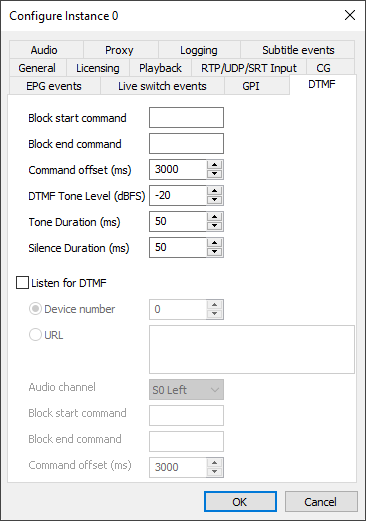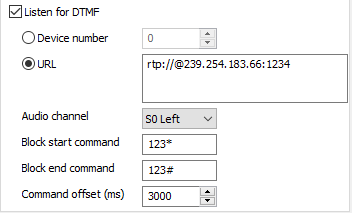DTMF
Reading time ~2 minutes
DTMF (Dual Tone Multi Frequency) tones are used to indicate the start and stop times of regional commercial insertion points.
|
Note
|
DTMF was originally designed to be applied on silence or over voice only (for telephony). Cinegy’s DTMF decoding is processed using the Goertzel algorithm, and also implements 2nd harmonic checks to separate DTMF from voice. However, there is no algorithm that can reliably decode DTMF signals applied over every possible background soundscape - for example, electronic music can easily generate false positives. Audio levels are also important, as well as the DTMF / background audio signal ratios as loud sound can destroy DTMF easily. Care and consideration should be used when relying on DTMF for critical triggers; instead, where possible more modern alternatives such as SCTE-35 should be used. |
The DTMF tones used in broadcasting are strings of 4 characters. The first 3 characters are an unique channel identifier, and the 4th character is either * for entering the next commercial block or # for exiting the current commercial block.
The valid characters for the unique channel identifier are limited to: 0-9, A-D, *, #.
DTMF Settings

For the output signal, the following parameters should be configured:
-
Block start command – specifies the command for automatic opt-out block start.
-
Block end command – specifies the command for automatic opt-out block end.
-
Command offset – defines the offset for DTMF triggers from the start of the automatic opt-out block.
-
DTMF Tone Level – specifies the DTMF tone volume, in dBFS.
-
Tone Duration – defines the DTMF tone duration, in ms.
-
Silence Duration – defines the pause between DTMF tones, in ms.
For DTMF tone receiving, the "Listen for DTMF" option should be selected:

Choose the type of incoming audio source – input device (NDI, SDI, Shared RAM, etc.) or IP – by selecting the "Device number" or "URL" radio button respectively, and then configure the following parameters:
-
Device number – define the input device number.
-
URL – define the URL of the incoming IP stream.
-
Audio channel – select the audio channel containing DTMF tones from the drop-down list.
-
Block start command – specify the command for automatic opt-out block start.
-
Block end command – specify the command for automatic opt-out block end.
-
Command offset – define the offset for DTMF triggers from the start of the commercial block.
|
Note
|
Any changes to the DTMF settings should be made before the particular item becomes cued; otherwise, the DTMF settings will not be applied for this item. |